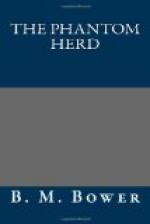He threw his grip into the waiting, three-seated spring wagon that served as a hotel bus, climbed briskly after it, and glanced ahead to where he saw the age-blackened boards of the stockyards. Cattle—and then came the sheep. So runs the epitaph of the range, and it was written plainly across Dry Lake and its surroundings.
They went up a dusty trail and past the yawning wings of the stockyards where a bunch of sheep blatted now in the thirst of mid-afternoon. They stopped before the hotel where, in the old days, many a town-hungry puncher had set his horse upon its haunches that he might dismount in a style to match his eagerness. Luck climbed out and stood for a minute looking up and down the sandy street that slept in the sun and dreamed, it may be, of rich, unforgotten moments when the cow-punchers had come in off the range and stirred the sluggish town to a full, brief life with their rollicking. Across the street was Rusty Brown’s place, with its narrow porch deserted of loafers and its windows blinking at the street with a blankness that belied the things they had looked upon in bygone times.
A less experienced man than Luck would have been convinced by now that here was no place to go seeking “real boys.” But Luck had been a range man himself before he took to making motion pictures; he knew range towns as he knew men,—which was very well indeed. He looked, as he stood there, not disgusted but mildly speculative. Two horses were tied to the hitching rail before Rusty Brown’s place. These horses bore saddles and bridles, and, if you know the earmarks, you can learn a good deal about a rider just by looking at his outfit. Neither saddle was new, but both gave evidence of a master’s pride in his gear. They were well-preserved saddles. They had the conservative swell of fork that told Luck almost to a year how old they were. One, he judged, was of California make, or at least came from the extreme southwest of the cattle country. It had a good deal of silver on it, and the tapideros were almost Mexican in their elaborateness. The bridle on that horse matched the saddle, and the headstall was beautiful with silver kept white and clean. The rope coiled and tied beside the saddle fork was of rawhide. (Luck did not need to cross the street to be sure of these details; observation was a part of his profession.) The other saddle was the kind most favored on the northern range. Short, round skirts, open stirrups, narrow and rimmed with iron. Stamped with a two-inch border of wild rose design, it pleased Luck by its very simplicity. The rope was a good “grass” rope worn smooth and hard with much use.
Luck flipped a match stub out into the dust of the street, tilted his small Stetson at an angle over his eyes, went over to the horses, and looked at their brands which had been hidden from him. One was a Flying U, and the other bore a blurred monogram which he did not trouble to decipher. He turned on his heels and went into Rusty’s place.




